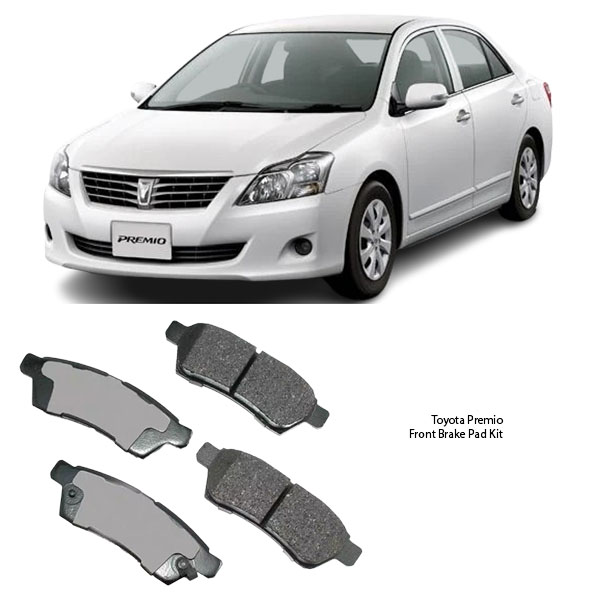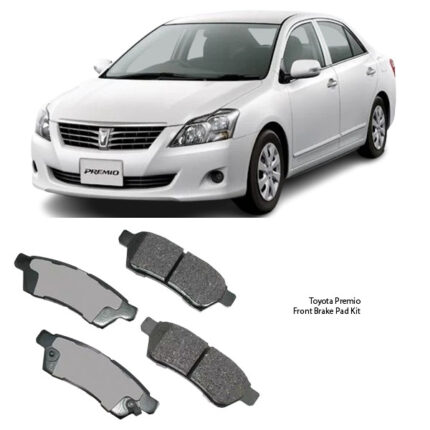Get Toyota Premio Front Brake Pad Kit D2118 in Kenya
The Front Brake Pad Kit is a crucial component of a vehicle’s braking system. It consists of the set of friction materials—commonly referred to as brake pads—that press against the brake discs (rotors) to create the friction necessary to slow down or stop the vehicle. Positioned in the front wheel braking system, these pads typically bear a greater braking load than the rear pads, especially in front-heavy vehicles, making their condition vital for overall braking performance and safety.
What Is a Front Brake Pad Kit?
A Front Brake Pad Kit typically includes:
-
A pair of brake pads for each front wheel (four in total—two per caliper)
-
Anti-rattle clips or shims
-
Pad wear indicators (mechanical or electronic)
-
Grease or lubricant for brake components (in some kits)
These components work together within the brake caliper, which houses the pads and applies the necessary pressure to bring the vehicle to a stop. Brake pads are generally made of friction materials bonded to a steel backing plate. Depending on the design and manufacturer, the friction material can be semi-metallic, ceramic, organic, or low-metallic NAO (Non-Asbestos Organic).
Function of Front Brake Pads
The primary role of front brake pads is to convert kinetic energy (motion) into thermal energy (heat) by pressing against the brake disc when the brake pedal is applied. This friction slows the rotation of the wheels and allows the vehicle to decelerate or come to a complete stop.
In most vehicles, especially those with front-engine configurations, up to 70% of the braking force is handled by the front brakes. This makes front brake pads even more critical than their rear counterparts.
Types of Brake Pad Materials
-
Semi-Metallic Brake Pads
Made from a mix of metals (like copper, iron, and steel) and friction modifiers. They offer strong performance and durability but can be noisy and create more brake dust. -
Ceramic Brake Pads
Known for being quiet, long-lasting, and producing less dust. They offer excellent performance but tend to be more expensive. -
Organic Brake Pads (Non-Asbestos Organic – NAO)
Composed of materials like glass, rubber, carbon, and Kevlar. They are softer, quieter, and more affordable but wear out faster. -
Low-Metallic NAO Brake Pads
These contain small amounts of metal and are designed for improved heat transfer and braking performance compared to organic pads, but they may generate more dust and noise.
Advantages of a High-Quality Front Brake Pad Kit
-
Superior Stopping Power
Good brake pads ensure consistent and powerful braking, improving vehicle safety under various driving conditions. -
Enhanced Durability
Premium pads are resistant to heat and wear, offering a longer lifespan and fewer replacements. -
Quieter Operation
Quality pads come with built-in shims or insulators to minimize squealing or grinding noises. -
Improved Brake Pedal Feel
A responsive, firm pedal contributes to confident braking and better vehicle control. -
Reduced Brake Dust
Advanced friction materials reduce dust accumulation on wheels, improving appearance and reducing cleaning needs. -
Fade Resistance
High-quality pads maintain performance during high temperatures, especially under repeated or aggressive braking.
Disadvantages of Worn or Poor-Quality Brake Pads
-
Longer Stopping Distances
Worn or inferior pads can’t generate enough friction, increasing the time and distance required to stop the vehicle. -
Brake Fade
Low-grade materials may overheat quickly and lose effectiveness, particularly during hard braking or downhill driving. -
Noise and Vibration
Poor pad quality or improper installation can result in squeaking, grinding, or vibration under braking. -
Increased Rotor Wear
Inferior pads may contain hard particles that cause grooves or scoring on the rotor, leading to expensive repairs. -
Safety Risk
In extreme cases, worn pads can lead to total brake failure, risking accidents and serious injury.
Signs That Front Brake Pads Need Replacing
-
Squealing or Screeching Sounds
High-pitched noise when braking usually indicates the wear indicator is touching the rotor. -
Grinding Noise
A metallic grinding sound often means the pads are completely worn out and the backing plate is contacting the rotor. -
Brake Warning Light
Some vehicles feature brake pad wear sensors that trigger a warning light on the dashboard. -
Reduced Braking Performance
If the car takes longer to stop or the pedal feels soft, worn brake pads could be the cause. -
Vibration When Braking
Warped pads or rotors can cause pulsation through the brake pedal. -
Visual Wear
If the pad material is less than 3mm thick, it’s time for a replacement.
How to Replace Front Brake Pads
Tools Required:
-
Jack and jack stands
-
Lug wrench
-
Socket set or spanner
-
C-clamp or brake caliper tool
-
Brake grease
-
New brake pads
Step-by-Step Process:
-
Lift the Vehicle
Safely lift the car and remove the front wheels. -
Remove the Caliper
Unbolt the brake caliper and carefully hang it using a wire or bungee cord to avoid stressing the brake line. -
Remove the Old Pads
Slide out the old brake pads. Take note of their orientation. -
Inspect and Prepare
Check the rotor for wear or damage. Clean the caliper bracket. Apply brake grease to the contact points to prevent noise. -
Install New Pads
Insert the new pads into the caliper bracket. Ensure they sit flush and are correctly aligned. -
Retract the Caliper Piston
Use a C-clamp or brake tool to push the piston back into the caliper to make room for the new pads. -
Reassemble
Reinstall the caliper over the new pads and tighten the bolts securely. -
Repeat on the Other Side
Always replace brake pads in pairs to maintain balanced braking. -
Test Brakes
Before driving, pump the brake pedal several times to seat the new pads and restore pressure.
Maintenance Tips
-
Inspect Regularly: Check brake pads at least every 10,000–15,000 km.
-
Avoid Hard Braking: Unless necessary, avoid aggressive braking which causes excessive wear and heat buildup.
-
Flush Brake Fluid: Maintain fresh brake fluid to ensure calipers function correctly.
-
Listen and Feel: Any unusual sounds or sensations when braking warrant an inspection.
Follow us on Facebook for more parts.




